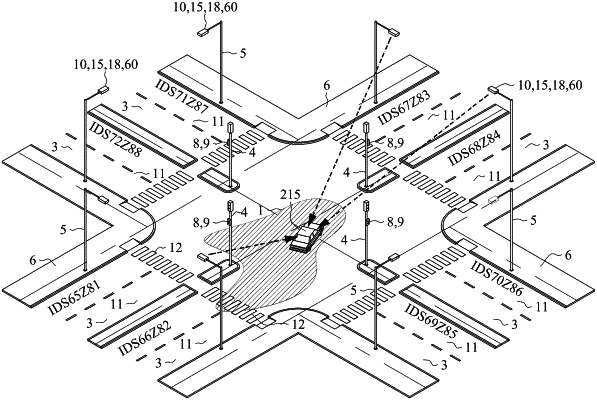| CPC H05B 47/105 (2020.01) [F21S 8/086 (2013.01); F21V 23/0442 (2013.01); F21V 23/06 (2013.01); F21V 29/74 (2015.01); H01F 27/24 (2013.01); H01F 27/2804 (2013.01); H01F 41/02 (2013.01); H01F 41/041 (2013.01); H04W 88/08 (2013.01); H05B 45/10 (2020.01); H05B 47/19 (2020.01); H05K 1/0298 (2013.01); H05K 1/115 (2013.01); H05K 1/181 (2013.01); F21W 2131/103 (2013.01); H05B 47/195 (2020.01); H05K 1/0233 (2013.01); H05K 1/165 (2013.01); H05K 2201/086 (2013.01); H05K 2201/0929 (2013.01); H05K 2201/1003 (2013.01); Y02P 70/50 (2015.11); Y10T 29/49117 (2015.01); Y10T 29/4913 (2015.01)] | 20 Claims |

|
1. A network comprising:
a plurality of intermediate device system (IDS) members, each IDS member coupled to a respective pole structure that electrically connects to a power source, each IDS member comprising
a local input interface,
a sensor configured to sense a parameter of an environmental condition of an area proximate to an IDS member that comprising a detection IDS member, the sensor comprising a camera, wherein
an optical field of view of the camera includes a predetermined region of a pathway, the optical field of view overlaps another optical field of view of a neighboring IDS member, and
an image sensor that captures optical information of the predetermined region of the pathway,
a pole mounted housing that contains therein
processing circuitry configured to receive the parameter of the environmental condition from the sensor and the optical information, and
a non-transitory computer readable memory that has code stored therein that upon execution of the code by the processing circuitry causes the processing circuitry to implement an AI engine that is trained to, upon receipt of the optical information and the parameter of the environmental condition, detect an existence of black ice or a time at which black ice estimated to form on a portion of the predetermined region of the pathway having the black ice or on which the black ice is estimated to form, and output a status indication of black ice, and
a wireless transceiver configured to transmit a wireless message that includes a real-time alert to a remote receiver, the wireless message including the status indication of the black ice and information about a location of the black ice on the portion of the predetermined region of the pathway, wherein
the remote receiver is hosted in at least one of a vehicle, a mobile device of a pedestrian, a neighboring IDS member, a road-side device that provides a wireless relay function, or a municipal/county facility.
|